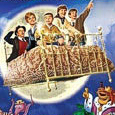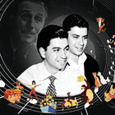Walt Disney Productions (1971), Walt Disney Studios Home Entertainment (September 8, 2009), 1 disc, 140 mins plus supplements, 1.66:1 ratio, Dolby Digital 5.1, Rated G, Retail: $29.99
Storyboard:
An amateur witch finds herself looking after three siblings in Wartime England. In the adventure of a lifetime, she enlists the aid of her instructor and together they travel to an animated land and fend off a Nazi raid.
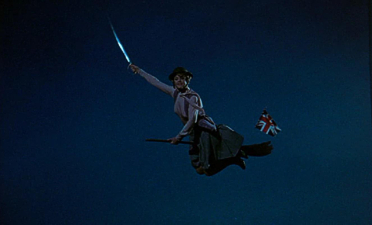
The Sweatbox Review:
This is the story of Walt Disney’s back-up plan. Walt tried for twenty years to purchase the rights to Pamela Lyndon Travers’ Mary Poppins stories, which had debuted in bookstores in 1934. Travers was more than reticent about her books being adapted by Hollywood, even despite Disney’s renown for quality. During the time period where her stubbornness was holding sway, Walt decided to instead purchase the rights to another series of English books that centered on a magical lady and some children. It might be argued whether this was insurance, or whether he did this to prod Ms. Travers, but it was probably a little of both. Certainly, his seriousness about the project is evident when you consider that he did enlist songwriters Richard and Robert Sherman to come up with songs to go with his new rights purchase, a pair of books by Mary Norton that had been combined into one volume, called Bedknob And Broomstick.
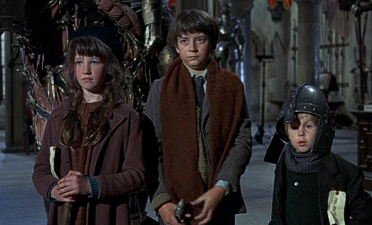
The first story, The Magic Bed-Knob, had been released in 1943, and told the tale of three children who met a witch named Eglantine who lived next-door to their aunt. The next book, 1957’s Bonfires And Broomsticks, had the children look up the witch again, and together they went back in time to 1666, where they met a fake magician named Emilius Jones. Walt had purchased the rights to the combined story, but as is often the case in Hollywood, most of the story elements got changed over the course of its prolonged production history. The movie first entered development with the Shermans while Mary Poppins’ negotiations languished, and then got abandoned once Walt’s first choice finally got the okay from Ms. Travers. The resulting Mary Poppins film, of course, got released in 1964 and became a cherished classic, even if Travers still didn’t particularly care for it.
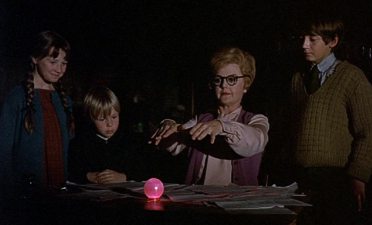
Later, Walt determined that Bedknob And Broomstick would serve as a nice follow-up to Mary Poppins, and work by the Shermans was resumed, under the working title The Magic Bedpost. The project was put on hiatus once again when Walt died in 1966, but eventually producer Bill Walsh brought the Shermans back to complete their work on the picture. This was an era where the studio found itself in disarray, and fell back on creating imitations of earlier successes. Thus, The Jungle Book begat Robin Hood, One Hundred And One Dalmatians begat The AristoCats, and Mary Poppins begat what became known as Bedknobs And Broomsticks. That is not entirely fair, of course, as each film has its own merits, and that is certainly true with the charming Bedknobs And Broomsticks. Unfortunately, that movie was given the additional and unfortunate handicap of being shortened prior to its release to accommodate a need to have it show at Radio City Music Hall, and to make it short enough for airlines.
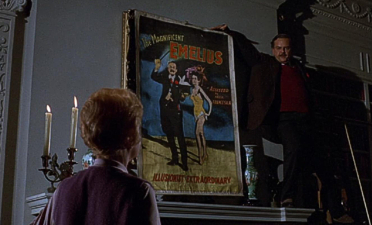
Thus, three musical sequences were removed before its 1971 premiere, and along with it much of the heart (not to mention some of the continuity) of the film. Furthermore, its 1979 reissue was further trimmed of twenty minutes, thereby taking out most of the songs and rendering the film quite limp. (That is the way that I first saw it. No wonder it left little impression on me at the time.) Fortunately, Disney’s Manager Of Library Restoration, Scott MacQueen, was able to locate the original lost footage in time for the film’s 25th Anniversary LaserDisc release. This added 22 minutes to the film, giving it an impressive runtime of 139 minutes. Since then, no other version has been entertained on home video, with both the original DVD release and this current one containing only the 139-minute version.
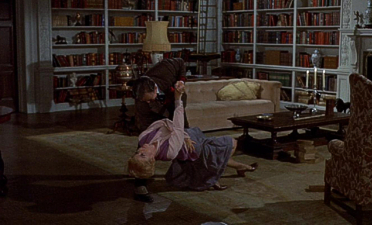
The film is a combined work by several of the Disney Studio’s most important men. Of course, there were the Sherman Brothers, but also other official Disney Legends who had likewise worked on Mary Poppins: writer/producer Bill Walsh, co-writer Don DaGradi, and director Robert Stevenson. Many other important crewmembers were naturally a part of the two films. Comparisons therefore become natural, though all would agree that Mary Poppins is the superior film in every way that matters. The one way in which Bedknobs And Broomsticks exceeds Mary Poppins was with its budget; it was the most expensive Disney film ever to that point in time. The Portobello Road set was also the largest set ever constructed at the studio. One has to admit, also, that the special effects in Bedknobs And Broomsticks were sometimes even more impressive than in Mary Poppins. The interplay between live action and animated elements is more sophisticated, and the climactic battle at the end (using suits of armor previously seen in the films El Cid and Camelot!) was spectacular for its time. In fact, the film that year won the Oscar for Best Visual Effects, one of five Academy Awards it was nominated for.
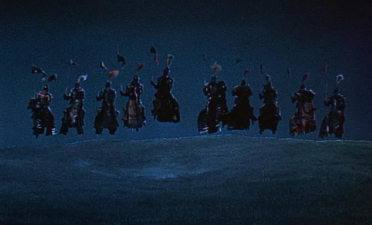
The story in the film diverges significantly from the books. All involved in the film’s development agreed that they liked the premise and the characters, but their main interest was in making a good picture, not to stay true to the book. Thus, the children’s aunt was lost, and the children went to stay with the nurse Eglantine herself, in order to escape the city before an expected Nazi invasion. The phoney magician became Eglantine’s instructor Professor Browne in the modern day. And the film’s exciting climax was inspired not by the books, but (so Disney legend goes) by Walsh’s memory of a newspaper story from World War II that concerned some witches gathering in England to prevent the Nazis from invading.
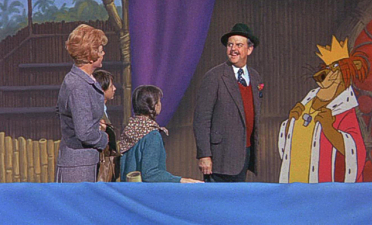
The film’s story was also modified to include a couple of animated sequences a la Mary Poppins. Ward Kimball, one of Walt’s “Nine Old Men,” directed the animation segments. The segments come consecutively just past the mid-way point of the film and add some zest to the proceedings. Taking place in a lagoon and on land at the isle of Naboombu, the cast of characters meet up with a number of fish and a lion king before observing a crazy soccer match. (Did they really call it “soccer” rather than “football”?)
The cast, as per most Disney films, is wonderful. Angela Lansbury beat out such luminaries as Julie Andrews, Maggie Smith, and Lynn Redgrave to become the ideal Eglantine. Professor Browne’s role went to David Tomlinson, who had, yes, appeared in Mary Poppins, but had also been used in the Disney hit The Love Bug in 1969. Roddy McDowall justifiably got third billing, though his role as a wannabe suitor for Eglantine is actually rather small.
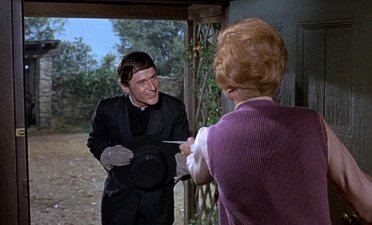
As mentioned, this disc includes the material located by Scott MacQueen. MacQueen’s finds include properly completing the 12-minute “Portobello Road” sequence, as well as the songs With A Flair and Nobody’s Problems For Me, as well as the second half of Eglantine. Of the additions, I would only argue that the “Portobello Road” sequence should have been cut down. Certainly it is wonderful to have it included at all, but by the time it lapsed into a “salute to nations,” complete with dancing Sikhs, calypso, and jazz, I was finding myself missing the flow of the narrative. Only one musical number, A Step In The Right Direction, could not be entirely recovered, as only its audio elements and some photos survived. It should also be noted that some of the new footage had to be re-dubbed, as the soundtrack elements were missing in those cases, but at least Disney was able to have Angela Lansbury and Roddy McDowell return to do the work. Some of the dubbing is quite distracting, mostly when Tomlinson’s stand-in is used, but most of it went unnoticed by me, until I saw so many people listed in the credits as doing ADR work for the restoration.
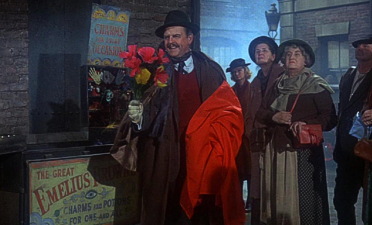
With such a strong pedigree, one would certainly hope that this film has some merit, and it certainly does. Saying that it falls short of Mary Poppins is somewhat akin to saying that a gourmet hamburger falls short of a filet mignon. Bedknobs And Broomsticks is a charming film in its own right, full of pleasant songs, wonderful performers, and lots of its own brand of magic. And they even fight Nazis! How cool is that? There are very few contemporary children’s films that I am interested in viewing today, but I know that I will be revisiting Bedknobs And Broomsticks again in the future.
Is This Thing Loaded?
The surprisingly satisfying suite of extras compiled for the recent reissue of another of the Studio’s live-action/animation combinations, Pete’s Dragon, led me to believe we might be in for another treat here. Sadly, the magic of the movie doesn’t spill over to the supplements. A Disney FastPlay disc, it spins into gear with previews for Snow White’s Diamond Edition, a trailer for The Princess And The Frog which recalls the great animated features of the 1990s, and Santa Buddies, among others in the Sneak Peek menu. A very nice main menu has the stars of the movie flying through its various lands and locations on the magic bed, a very nice touch.

When it comes to the supplements proper, Bedknobs And Broomsticks unfortunately follows The Sword In The Stone and Mary Poppins’ 45th Anniversary Editions in actually featuring less material than their previously released counterparts. Top of the new list, but not top of the class, is The Wizards Of Special Effects featurette, hosted by Jennifer Stone from The Wizards Of Waverly Place (see what they did there?). You might be hoping for something from this, considering it also gets a sticker push on the front of the slipcover, but although Stone is playful, there’s the same almost-apologizing for the naivety of the special effects as was on the Pete’s Dragon disc, even though Bedknobs won an Oscar for its visuals and they still hold up better than the Waverly Place examples shown! It gets better as historian Les Perkins and others fill in with the technical stuff, but really this goes over the same ground as the Pete’s Dragon featurette and doesn’t do so nearly as well. That more than half of the brief eight minutes is actually spent talking about the effects for Wizards Of Waverly Place tells you all you need to know.
Seemingly carried over from the Gold Collection of before, Music Magic: The Sherman Brothers is a better look at the production but has been chopped almost in half (from 20 minutes down to 11) to make way for the Jennifer Stone piece. Still, this is production history from the horses mouths as Robert and Richard Sherman fill us in on the back-up plan to a stalled Poppins and how Bedknobs eventually came to be. A much-known fact is how Beautiful Briny Sea was originally written for Poppins, and the story of how Don DaGrady captured the moment Walt fell to sleep during a song pitch for Eglantine is recalled as the Shermans go into their thought process for some of the other songs. Production footage of the filming is nice to see, however briefly glimpsed, as are sound bites from Angela Lansbury, but it would have been cool to see and hear more, and it feels like a longer documentary is itching to break out, especially Lansbury’s sign off to camera. It was longer on the previous edition, where a look into MacQueen’s exhaustive restoration efforts are sorely missed here.
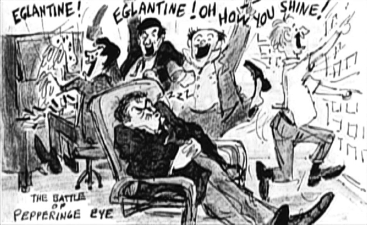
One of the songs that could not be restored was A Step In The Right Direction, heard as an instrumental in both cuts of the movie when Miss Price first takes her broomstick out for a spin. The music and vocal track were discovered, but the picture element has yet to be unearthed, so for the 25th Anniversary LaserDisc, MacQueen reconstructed the sequence using still photographs. That’s been ported over complete with the text information that references the “25th Anniversary” dating, and it’s still a fun sequence. Disney fans will still recognize the melody from the three minute clip as It’s A Big, Bright, Beautiful Tomorrow, which the Shermans adapted for the Carousel Of Progress at Disneyland after the song was cut from the picture.
A David Tomlinson Portobello Road Recording Session might sound fascinating, but it’s just a minute-long silent clip of the actor in the studio, conducted by Irwin Kostal, with the completed song laid over the soundtrack. While it’s interesting to see Tomlinson as himself before taking on the Emelius Browne look, this could have been inserted more seamlessly in the Sherman featurette, where it would have at least had a bit of context. Lastly, and showing what a lacklustre edition this really is, four theatrical trailers have been again pulled from the 25th Anniversary LaserDisc. Three original release trailers vary from an almost four minute “pack it all in” spoiler previews to more convention shorter spots, but the best is for a 1979 reissue whose campaign rode on the success of Superman: The Movie and proclaimed “You’ll believe a woman can fly”! The last extra is a cut-down version of The Suite Life’s Dylan and Cole Sprouse’s plug for the benefits of Blu-ray, but as it’s neither new or relevant to the movie we’ll skip it here.
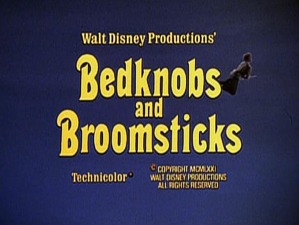
For those coming to Bedknobs And Broomsticks on DVD for the first time, the supplements gathered may appeal enough to satisfy, but it should be pointed out that the previous Gold Edition of the same title included more. The addition of the Disney Channel kids segments is a shame considering some pertinent material on the restoration has been dropped instead, and although they were not tied to the feature, two classic cartoon shorts have likewise not been carried over. The Sodium Vapor process was more than adequately explored in this disc’s companion release of Pete’s Dragon, so why cover the same ground again in a less entertaining way? Clearly there is scope for improvement. How about a two-disc edition, featuring both the original theatrical and restored cuts of the film for comparison? And while they’re at it, include this year’s documentary retrospective The Age Of Believing: The Live-Action Disney Classics, which suitably takes its title from this very film. Oh , well…there’s always Blu-ray…
Case Study:
The standard keepcase comes with an identical but embossed and slightly shinier O-sleeve, which dresses this release up very elaborately but only plays up the lack of fulfilling supplements as all the more disappointing. The Enchanted Musical Edition tag looks like an afterthought, and this is yet another sleeve that features the blasé “Walt Disney”-only signature along the top, giving it no great distinction (as, neither, does the redundant “from the studio that brought you Mary Poppins does at the foot of the front). The black case has those annoying side snaps. There is a Disney Movie Rewards insert inside, as well as a Blu-ray booklet.
Ink And Paint:
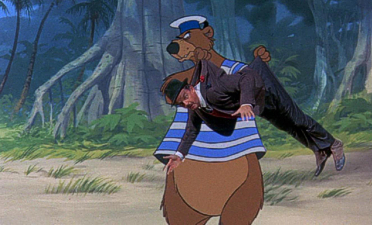
Presented in its “open matte” negative aperture on the 25th Anniversary LaserDisc restoration, Bedknobs And Broomsticks was matted to a Disney Studio-standard theatrical ratio of 1.66:1 for its previous DVD release, and it’s the same transfer that we get again here. The original LD still holds up pretty well today, so the benefits are only marginal given the benefits of DVD. The print is in good shape, with only minor fluctuations that do not distract from the enjoyment. Images are colorful and sharper than expected, with a light layer of grain preserving the film’s age, but blacks are strong. Even the multi-composited effects sequences are free of debris, ironically leaving the roughest portion to be MacQueen’s couple of minutes of restoration credits on the tail. Surprisingly detailed, Bedknobs And Broomsticks sports great depth in this fine presentation of an overlooked film.
Scratch Tracks:
I already mentioned that in Scott MacQueen’s restoration work, some elements could not be found, and this included a few audio trims. With Lansbury and McDowall (at the time) still available, they were called in to re-record several lines, but it was down to the “Disney Character Voices” to try and replicate some of the other performances. One of the kids sounds like Dick Van Dyke on a Mary Poppins off day for one or two lines, but the most noticeable change is Professor Browne, who not only is recorded too cleanly but isn’t the best match for David Tomlinson.
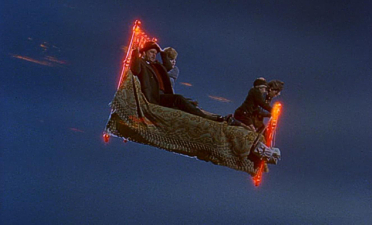
MacQueen was only able to complete these sections on a direct-to-video budget, meaning that some synthesized music is also heard briefly in the Nobody’s Problems reprise. Even though these instances may still leap out at some long-time fans of the film, the rest of this 5.1 track does attempt to cushion those moments in the mix. It works hard to create an enveloping update to the original track while preserving a natural sound. English and French 5.1 are optional, as are English, French and Spanish subtitles.
Final Cut:
Put your preconceived ideas aside. This is not a mere follow-up to Mary Poppins, or a vain attempt to recapture past glory. This is a genuinely nice, slick family film that has plenty of its own Disney magic. Though the extended cut does have some issues, it is still the preferable way to see the film. Still, this seems like a botched opportunity to improve on the previous DVD release. A better, true collector’s edition would have been more favourable, with the original and extended cuts of the film, plus a full slate of special features. As it is, this release actually trims down the extras from the old DVD, making this edition a bit of a puzzle. The addition of Disney Channel tie-ins makes it even less palatable. Still, I wouldn’t dissuade anyone from picking up this DVD if they simply want to experience a film in which every Disney fan should have an interest.
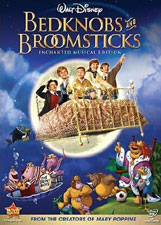 | ||
 |


